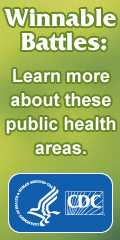August 2017
Did You Know? is a weekly feature from the Office for State, Tribal, Local and Territorial Support to inform your prevention activities. We invite you to read, share, and take action!
View the Current Did You Know?
August 25, 2017
- Psittacosis, an infection people most often get from pet birds, is a nationally notifiable condition, but diagnosis can be challenging so the illness might be underreported.
- New guidelines [PDF-232KB] from the National Association of Public Health Veterinarians can help health professionals identify psittacosis.
- CDC offers a laboratory test that can improve diagnosis; learn how to request the test.
August 18, 2017
- Most fungi are not dangerous, but some types of fungal diseases can be harmful and even deadly for those with weakened immune systems.
- Of the 1.5 million species of fungi, only about 300 of them are known to make people sick.
- Sharing information to increase awareness about fungal diseases is one of the most important ways to reduce delays in diagnosis and treatment—and to potentially save lives.
August 11, 2017
- The number of motor vehicle crashes involving 17- and 18-year old drivers increased in 2014 and 2015, and crashes remained the leading cause of death for US teens.
- Eight danger zones—like driver inexperience and nighttime driving—contribute to teen crashes.
- The strategies in CDC’s Graduated Driver Licensing System Planning Guide can help states evaluate and improve their programs addressing these leading causes of teen driver crashes.
August 4, 2017
- Syphilis rates are increasing across many US communities [PDF-2.8MB]—and even among newborn babies.
- Syphilis is easy to treat and cure with the right medication but can have serious complications [PDF-996KB] if left untreated.
- CDC’s new whiteboard video for healthcare providers highlights syphilis trends, describes key testing recommendations for at-risk groups, and discusses three steps providers can take to protect their patients―talk, test, and treat.
Did You Know? information and web links are current as of their publication date. They may become outdated over time.
- Page last reviewed: August 25, 2017
- Page last updated: August 25, 2017
- Content source:



 ShareCompartir
ShareCompartir



